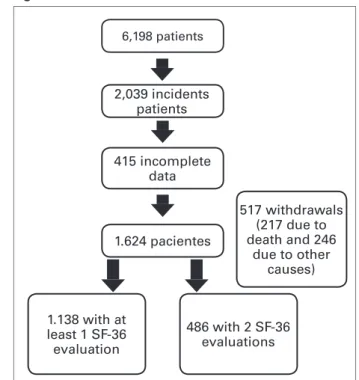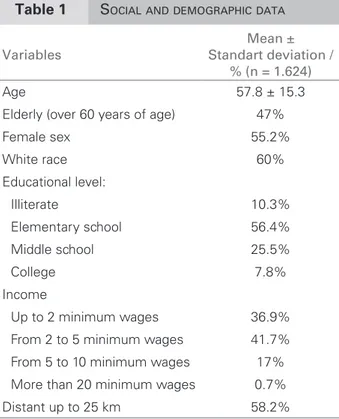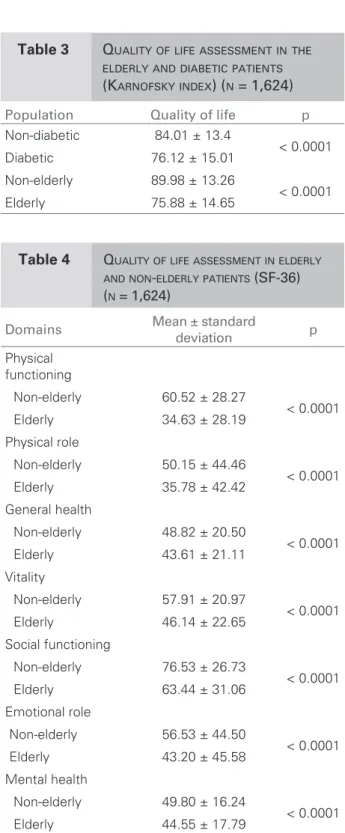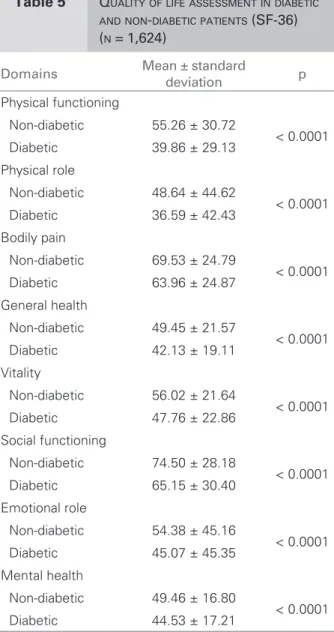Authors
Fabiane Rossi dos Santos Grincenkov1,2
Natália Fernandes1,3 Alfredo Chaoubah4 Kleyton Bastos5 Abdul Rashid Qureshi6 Roberto Pecoits-Filho7 José Carolino Divino Filho7
Marcus Gomes Bastos3
1 Núcleo Interdisciplinar de Estudos e Pesquisas em Nefrologia; Universidade Fe-deral de Juiz de Fora – UFJF 2 Departamento de Psico-logia; Centro de Ensino Superior de Juiz de Fora 3 Departamento de Medicina – UFJF
4 Departamento de Estatística – UFJF
5 Departamento de Medici-na- Universidade Federal de Sergipe – SE
6 Baxter Novum and Renal Medicine, CLINTEC, Karo-linska Institute, Stockholm, Sweden
7 Centro de Saúde e CiÍncias Biológicas; Pontifícia Univer-sidade Católica do Paraná – PUC PR
Submitted on: 09/17/2010 Accepted on: 11/03/2010
Corresponding author: Fabiane Rossi dos Santos Grincenkov
Fundação IMEPEN Rua José Lourenço Kelmer, 1300/208-222, São Pedro Juiz de Fora – MG – Brazil CEP: 36036330
E-mail:
fabpsic@yahoo.com.br
The present study was conducted by the Interdis-ciplinary Group of Study and Research in Nephrolo-gy, Universidade Federal de Juiz de Fora.
Authors declare no conflict of interest.
A
BSTRACTIntroduction: The number of patients on peritoneal dialysis (PD) in Brazil is signifi-cant, with a higher prevalence of diabetic and elderly individuals on PD than on he-modialysis. These data point to a selection bias in that population. Objective: To as-sess the quality of life (QoL) of patients starting PD in Brazil. Methods: The study assessed 6,198 patients participating in a multicenter prospective cohort study, us-ing data from BRAZPD. The QoL was assessed by use of the Karnofsky index (QoL assessment by health professionals) and the SF-36 (patient’s self-assessment) in 1,624 incident patients. Results: Of the patients analyzed, 40% were diabetic and 47% were elderly (over the age of 60 years). Patients had low QoL scores in all the SF-36 domains, the “physical role” do-main being the most affected and the “so-cial functioning” domain having the best score. On the other hand, according to the Karnofsky index, most patients had high QoL scores. Elderly and diabetic patients had lower QoL as compared with non-elderly and non-diabetic by using both the SF-36 and Karnofsky index. Conclusion: The overall evaluation by use of the SF-36 showed a reduction in the QoL. The Karnofsky index showed a better QoL as compared with the SF-36 assessment, but similar results were found in the sub-groups evaluated: the ederly and the dia-betic patients had the worst QoL in both assessments.
Keywords: peritoneal dialysis, quality of life, SF-36, Karnofsky index.
[J Bras Nefrol 2011;33(1): 23-28]©Elsevier Editora Ltda.
Factors associated with the quality of life of incident
patients on PD in Brazil (BRAZPD)
I
NTRODUCTIONPatients with chronic kidney disease (CKD) usually tend to show a reduction in their quality of life (QoL) because of the several restrictions resulting from CKD treatment. Some studies have re-ported no difference in the QoL of pa-tients undergoing hemodialysis (HD) as compared with that of patients un-dergoing peritoneal dialysis (PD), since both groups have a reduction in scores.1 However, some authors, such as Zhang et al.2, have reported a better QoL of pa-tients undergoing PD.
The presence of diabetes is a factor that can influence the QoL of such pa-tients. As compared with non-diabetic patients, diabetic patients use more medications, score lower in the physical domains of the Medical Outcomes Study 36-Item Short-Form Health Survey (SF-36), and have greater blood pressure lev-els, more cardiovascular complications, a worse self-perception of QoL, lower physical functioning, and higher mortal-ity.3 The presence of comorbidities can, thus, relate to the reduction in QoL.
The predominance of elderly and dia-betic patients in the population on HD can influence negatively certain QoL do-mains, as compared to other subgroups of patients.4
Figure 1. Patients evaliation flow.
Factors, such as age and presence of diabetes, can, thus, influence significantly the QoL of patients with CKD. Interventions enhancing the clinical conditions and QoL of those patients are paramount, since the latter is directly associated with mortality in that population.
The association between the reduction in QoL and preventable and controllable factors points to the importance of psychosocial interventions in that population.6
This study aimed at assessing the QoL of patients with CKD at the beginning of the treatment with PD in Brazil.
P
ATIENTSANDM
ETHODThis prospective multicenter cohort study comprised 6,198 patients and used data from the BRAZPD (Estudo Clínico Multicêntrico em Diálise Peritoneal – Brazilian Multicenter Clinical Study on PD). This study included 114 centers of renal replacement ther-apy (RRT) with more than ten patients on PD using the Baxter systems. At all centers, a physician and a nurse were trained to enter the patients’ information into the data base by using the PDnet software, espe-cially developed for the study.
Figure 1 shows that of 6,198 patients, 2,039 were incident. Four hundred and fifteen patients lacked complete QoL data for analysis, leaving, thus, 1624 patients in the study. There were 517 widthdrawls, 271 due to death and 246 due to other causes.
Assessment of QoL was performed by use of two instruments: the Karnofsky performance scale index7 and the SF-36.8 Assessment according to the Karnofsky index, whose maximum score of 100 points corresponds to the best QoL, was per-formed monthly by health professionals (nurses).
The SF-36 was used to assess 3642 patients. The SF-36 is a self-reported questionnaire, a re-duced version of the Medical Outcomes Trust questionnaire, translated into Portuguese and vali-dated. The SF-36 assesses the following domains: physical functioning; physical role; bodily pain; general health perceptions; vitality; social func-tioning; emotional role; and mental health. Scores ranging from zero to 100, corresponding to the worst and best QoL, respectively, are attributed to each domain assessed.
The BRAZPD applied the SF-36 for QoL assess-ment at the following times: 1) six months after be-ginning PD for incident patients; 2) three months after entering the study for prevalent patients.
Physucuans and nurses performed the data col-lection. The present study assessed the most af-fected QoL domains at the beginning of dialysis for incident patients by assessing two subgroups: the elderly and the diabetic patients.
The nurses entered the following data of this clinical study: age; race; educational level; mean monthly income (in classes of minimum wages, according to the Brazilian Institute of Geography and Statistics);9 and distance between the patient’s residence and dialysis center (kilometers).10 The physicians entered the following data: 1) CKD eti-ology (based on the classification of the European Dialysis and Transplant Association – EDTA); 2) pre-dialysis care (in case of follow-up, time in years and months); 3) instructions about the RRT types to patients; 4) indication for PD (patient’s option, medical indication, or the only possible therapy); 5) specialty of the professional who referred the patient; 6) presence and type of vascular access; 7) dialysis history, including the current and previ-ous RRT and the time spent in each therapy.10
Assessment of comorbidities was based on the score criterion used by Davies et al.11 Previous data about infection included all infections (peritonitis, catheter exit site, and catheter subcutaneous tun-nel) occurring before the patient entered the study. The project was approved by the National Committee on Ethics and Human Research un-der the number 448. Patients participating in the study provided written informed consent.
6,198 patients
2,039 incidents patients
415 incomplete data
1.624 pacientes
1.138 with at least 1 SF-36 evaluation
517 withdrawals (217 due to death and 246
due to other causes)
STATISTICALANALYSIS
Statistical descriptive analysis was performed. Then, the elderly versus non-elderly and diabetic versus non-diabetic populations were compared in the eight SF-36 domains and with the Karnofsky index, by using the Student t test for independent samples or Mann Whitney with the Bonferroni test. The signifi-cance level of p ≤ 0.05 was adopted. The software SPSS 13.0 was used for data analysis.
R
ESULTSThe total population comprised 6,198 patients, and 1,624 incident patients (on PD for more than three months), who had all data required, were assessed.
Table 1 shows the social and demographic data of the population assessed. Mean age was 57.8 ± 15.3 years, 47% of the patients were elderly (over the age of 60 years), 55.2% were of the female sex, and 60% were white. Regarding educational level, 10.3% were illiterate, 56.4% had elementary school education, 25.5% had middle school education, and 7.8% had college education.
Regarding income, 36.9% of the patients received up to two minimum wages, 41.7% received from two to five minimum wages, 17% from five to ten mini-mum wages, 3.8% received from ten to 20 minimini-mum wages, and 0.7% received more than 20 minimum wages. Most participants in the study (58.2%) lived within 25 km from the dialysis center.
Table 2 shows the clinical characteristics of the sample. The etiology of the disease was as follows: diabetic nephropathy, 36.9% of the patients; hyper-tensive nephrosclerosis, 22.7%; chronic glomerulo-nephritis, 11%; undetermined etiology, 14%; and others, 15.4%.
Of the patients assessed, 55.7% had been fol-lowed up prior to dialysis.
The comorbidities were as follows: systemic hypertension, 90.3%; left ventricular hypertrophy (LVH), 44%; diabetes, 40%; peripheral vascular dis-ease, 25.6%; heart failure, 25%; neoplasias, 2.6%; and collagenosis, 2.4%. Only 2.2% of the patients had no comorbidities.
The QoL assessment by use of the Karnofsky in-dex is shown in percentiles in Figure 2. Most pa-tients had high scores of QoL as follows: 75% had QoL scores greater than 90, and 50% had QoL scores greater than 70.
The QoL assessment by use of the SF-36 showed low scores of QoL in all domains, “physical role” and “mental health” being the most impaired. The “social functioning” domain had the highest score (Figure 3).
When comparing the subgroups, the elderly and the diabetic patients scored lower than non-elderly and non-diabetic by using the Karnosfsky index (Table 3) and the SF-36 (Tables 4 and 5).
Variables
Mean ± Standart deviation /
% (n = 1.624)
Age 57.8 ± 15.3
Elderly (over 60 years of age) 47%
Female sex 55.2%
White race 60%
Educational level:
Illiterate 10.3%
Elementary school 56.4%
Middle school 25.5%
College 7.8%
Income
Up to 2 minimum wages 36.9%
From 2 to 5 minimum wages 41.7%
From 5 to 10 minimum wages 17%
More than 20 minimum wages 0.7%
Distant up to 25 km 58.2% Table 1 SOCIAL AND DEMOGRAPHIC DATA
Variables % (n = 1,624)
Etiology of CKD
Diabetic nephropathy 36.9
Hypertensive nephrosclerosis 22.7
Chronic glomerulonephritis 11
Undetermined etiology 14
Others 15.4
Pre-dialysis follow-up 55.7
Comorbidades
Systemic arterial hypertension 90.3
LHV 44
Diabetes 40
Peripheral vascular disease 25.6
Heart failure 25
Neoplasias 2.6
Collagenosis 2.4
No comorbidities 2.2
Table 2 CLINICAL CHARACTERISTICS
Figure 2. General quality of life assessed by use of the Karnofsky index (n = 1,624).
Figure 3. General quality of life assessed by use of SF-36 (n = 1,624).
80 70 60 50 40 30 20 10 0
PF PR PAIN GHP VIT SF ER MH
D
ISCUSSIONPatients with CKD show a significant reduction in their QoL when compared with the general popula-tion, and an association exists between kidney func-tion and the scores used to assess well-being and QoL.12 One factor that could contribute effectively to improve the QoL of patients with CKD would be a reduction in the number of comorbidities.2
The present study assessed the QoL of patients un-dergoing PD, in which elderly and diabetic patients prevailed. Such patients usually have greater physical, psychic, and social impairments.
In this study, the general assessment of QoL dif-fered according to the instrument used. By use of the Karnofsky index, in which the QoL assessment is performed by a health professional, the patients showed a satisfactory QoL. On the other hand, when the self-reported SF-36 was used, the QoL scores were reduced, specially the “physical role” and “emotional role” domains. These results indi-cate that the vision of the health team about the QoL
of their patients may be different from the patients’ own perception of their health state. However, when assessing the elderly and diabetic subgroups, no dif-ference was observed between the results obtained by use of the two instruments. The elderly and dia-betic patients maintained the worst performance, with the bias of the Karnofsky index showing better scores. Thus, it is worth emphasizing the importance of listening to the patient in regard to his/her process PF: physical functioning; PR: physical role; GHP: general health
perception; SF: social functioning; ER: emotional role; MH: mental health.
Population Quality of life p
Non-diabetic 84.01 ± 13.4
< 0.0001 Diabetic 76.12 ± 15.01
Non-elderly 89.98 ± 13.26
< 0.0001 Elderly 75.88 ± 14.65
Table 3 QUALITY OF LIFE ASSESSMENT IN THE ELDERLY AND DIABETIC PATIENTS (KARNOFSKY INDEX) (N = 1,624)
Domains Mean ± standard deviation p
Physical functioning
Non-elderly 60.52 ± 28.27
< 0.0001 Elderly 34.63 ± 28.19
Physical role
Non-elderly 50.15 ± 44.46
< 0.0001 Elderly 35.78 ± 42.42
General health
Non-elderly 48.82 ± 20.50
< 0.0001 Elderly 43.61 ± 21.11
Vitality
Non-elderly 57.91 ± 20.97
< 0.0001 Elderly 46.14 ± 22.65
Social functioning
Non-elderly 76.53 ± 26.73
< 0.0001 Elderly 63.44 ± 31.06
Emotional role
Non-elderly 56.53 ± 44.50
< 0.0001 Elderly 43.20 ± 45.58
Mental health
Non-elderly 49.80 ± 16.24
< 0.0001 Elderly 44.55 ± 17.79
Table 4 QUALITYOFLIFEASSESSMENTINELDERLY ANDNON-ELDERLYPATIENTS (SF-36)
(N = 1,624) 75%
Maior que 90 Maior que 80 Maior que 70
25%
of treatment, limitations, and possibilities. Another point to be stressed is the fact that, although the Karnofsky index can be considered a QoL instru-ment13, it assesses only physical performance. The concept of QoL involves not only physical, but also social, psychic, and spiritual well-being.14 This is one of the limitations of the present study, because an instrument that assesses only physical performance was used as a parameter of QoL, ignoring the other parameters assessed by use of the SF-36.
The concept of QoL is defined as the individual’s perception about his/her position in life, cultural context, system of values, objectives, expectations, patterns, and concerns. That concept involves as-pects such as subjectivity, multiple dimensions, and presence of positive and negative dimensions.14 Therefore, that is a multifactorial and subjective
concept, and, thus, important to be assessed by the own individual.
In the assessment by use of SF-36, the “physical role” and “mental health” domains were the most impaired. Numerical assessments can sometimes measure subjective aspects, such as the impact that the disease and treatment may have. Such measure-ments allow the perception of the effect that dialy-sis may have on psychic and physical conditions of CKD patients. The chronicity of the disease in asso-ciation with comorbidities and advanced age are fac-tors that can significantly impact the patients’ daily activities, social relations, and mental health.
The QoL assessments in the elderly group showed that they had a reduction in their QoL as compared with non-elderly. Such results are in accordance with those found in the literature, because age is a factor that can have a negative impact on the QoL indi-ces. Kusztal et al. 15, studying CKD patients, have reported that the impact of aging was more evident on the physical domains of the SF-36. Similar results were found in a study of HD patients, which showed a negative correlation between age and the QoL do-mains, such as physical functioning, role limitation due to physical health, bodily pain, general health perceptions, vitality, and social functioning.16 Castro et al. 17 have also reported a negative correlation be-tween age and the following SF-36 domains in pa-tients on HD: physical functioning; physical role; bodily pain; and vitality. The authors emphasize that the presence of chronic disease, need for continuous and long treatment, advanced age, and presence of comorbidities are factors that can interfere with the QoL of that population.
In our study, diabetic patients also had lower QoL than non-diabetic patients. In the SF-36 assessment, the “physical role” domain was the most impaired in diabetic and elderly patients. Similarly to those results, Mingardi et al.18 have reported that, among dialysis patients assessed by use of the SF-36, dia-betics also had significantly lower scores regarding physical role. The impact of aging was more evident in the physical domains. Barbosa et al. 19, studying HD patients, have reported that the presence of co-morbidities, such as diabetes and peripheral vascular disease, in addition to more advanced age, were sig-nificantly associated with lower scores in at least one of the SF-36 dimensions.
The results of the present study emphasize the influence of factors, such as, advanced age and dia-betes, in the reduction of the QoL parameters of pa-tients undergoing PD.
Domains Mean ± standard deviation p
Physical functioning
Non-diabetic 55.26 ± 30.72
< 0.0001 Diabetic 39.86 ± 29.13
Physical role
Non-diabetic 48.64 ± 44.62
< 0.0001 Diabetic 36.59 ± 42.43
Bodily pain
Non-diabetic 69.53 ± 24.79
< 0.0001 Diabetic 63.96 ± 24.87
General health
Non-diabetic 49.45 ± 21.57
< 0.0001 Diabetic 42.13 ± 19.11
Vitality
Non-diabetic 56.02 ± 21.64
< 0.0001 Diabetic 47.76 ± 22.86
Social functioning
Non-diabetic 74.50 ± 28.18
< 0.0001 Diabetic 65.15 ± 30.40
Emotional role
Non-diabetic 54.38 ± 45.16
< 0.0001 Diabetic 45.07 ± 45.35
Mental health
Non-diabetic 49.46 ± 16.80
< 0.0001 Diabetic 44.53 ± 17.21
Table 5 QUALITYOFLIFEASSESSMENTINDIABETIC ANDNON-DIABETICPATIENTS (SF-36)
C
ONCLUSIONIn this multicenter prospective cohort study, using data from the BRAZPD, elderly and diabetic pa-tients predominate, suggesting the existence of a bias of negative selection for PD in our country.
The self-assessment by use of SF-36 revealed a low QoL of the patients, “physical role” being the most impaired domain. The elderly and the diabetic patients showed the worst QoL, emphasizing their need for special attention. The Karnofsky index did not show good compatibility with the SF-36 results in the general analysis of QoL. In face of these find-ings, it is worth emphasizing the importance of valu-ing the patient’s perception about his/her own health state.
R
EFERENCES1. Wasserfallen JB, Halabi G, Saudan P et al. Quality of life on chronic dialysis: comparison between hae-modialysis and PD. Nephrol Dial Transplant 2004; 19:1594-9.
2. Zhang AH, Cheng LT, Zhu N et al. Comparison of quality of life and causes of hospitalization between HD and PD patients in China. Health Qual Life Outcomes 2007; 5:49.
3. Martinez-Casteano A, Gorriz JL, Garcia-Lopez F et al. Perceived health-related quality of life and comorbid-ity in diabetic patients starting dialysis (CALVIDIA study). J Nephrol 2004; 17:544-51.
4. Vasquez I, Valderrabano F, Jofré R et al. Psychosocial factors and quality of life in young HD patients with low comorbidity. J Nephrol 2003; 16:886-94.
5. Chow FYF, Briganti EM, Kerr PG et al. Health-related quality of life in Australian adults with renal insuf-ficiency: a population-based study. Am J Kidney Dis 2003; 41 (3): 596-604.
6. Lopes AA, Bragg-Gresham JL, Goodkin DA et al. Factors associated with health-related quality of life among HD patients in the DOPPS. Qual Life Res 2007; 16:545-7.
7. Karnofsky DA, Burchenal JH. The clinical evaluation of chemotherapyc agents in cancer. In: Evaluation of Chemoterapic Agents. Edited by Mc Leod CM. New York: Columbia University Press 1949. pp. 191-205.
8. Cicconelli, R. M. Tradução para o português e valida-ção do questionário genérico de avaliavalida-ção de qualidade de vida “Medical Outcomes Study 36-item-short-form health survey (SF-36)”. [Tese de Doutorado] São Paulo: Escola Paulista de Medicina, Universidade Federal de São Paulo 1997.
9. Instituto Brasileiro de Geografia e Estatística. In: http:// www.ibge.gov.br. Acessado em: abril de 2007.
10. Fernandes N, Bastos MG, Cassi HV et al. On behalf of the Brazilian PD Multicentric Study (BRAZPD) Group. The Brazilian PD Multicentric Study (BRAZPD): Characterization of the Cohort. Kidney International 2008; 73:145-51.
11. Davies Sj, Phillips L, Naish Pf, Russel GI. Quantifying comorbidity in PD patients and its relationship to other predictors of survival. Nephrology Dialysis Transplantation 2002; 17:1085-92.
12. Gorodetskaya I, Zenios F, Mcculloch CF et al. Health-related quality of life and estimates of utility in chronic kidney disease. Kidney Int 2005; 68:2801-08.
13. Danquah NFV, Wasserman J, Meininger J, Bergstrom N. Quality of Life Measures for Patients On HD: A Review of Psychometric Properties. Nephrology Nursing Journal 2010; 37:255-69.
14. Fleck MPA, Louzada S, Xavier M et al. Aplicação da versão em português do instrumento abreviado de qualidade de vida – WHOQoL-bref 2000. Rev Saúde Pública 2000; 34:178-83.
15. Kusztal M, Nowak K, Magott-Procelewska M, Weyde W, Penar J. Evaluation of health-related quality of life in dialysis patients. Personal experience using question-ary SF-36. Pol Merkuriusz Lek 2003; 14:113-7. 16. Santos PR. Relação do sexo e da idade com nível de
qualidade de vida em renais crônicos hemodialisados. Revista Associação Médica Brasileira 2006; 52:356-9. 17. Castro M, Caiuby AVS, Draibe AS, Canziani MEF.
Qualidade de vida de pacientes com insuficiência renal crônica em hemodiálise avaliada através do instrumen-to genérico SF-36. Revista Associação Médica Brasileira 2003; 49:245-9.
18. Miningardi G, Cornalba L, Cortinovis E, Mosconi P, Apolone G. Health-related quality of life in dialy-sis patients. A report from na Italian study using the SF-36 Health Survey. Nephrol Dial Transplant 1999; 14:1503-10.



